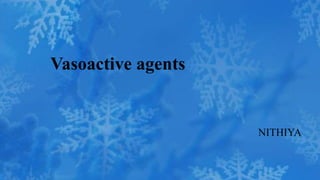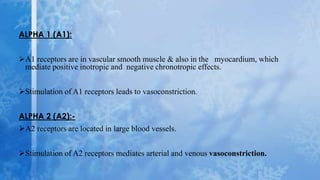This document discusses vasoactive agents and their receptor physiology and clinical applications. It begins by outlining the objectives of understanding vasopressor and inotropic receptor physiology and appropriate clinical use. It then provides background on vasopressors, inotropes, and drugs that have both effects. The majority of the document then discusses the receptor physiology and mechanisms of action of various adrenergic, dopaminergic, and vasopressin receptors. It also covers individual drug classifications, effects, indications, and considerations for agents like epinephrine, norepinephrine, dopamine, dobutamine, milrinone, vasopressin, levosimendan, and vasodilators. Studies comparing agents































































